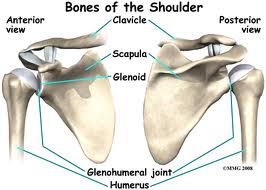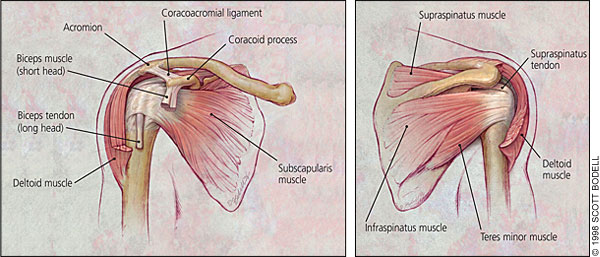The glenohumeral joint more commonly known as the shoulder joint is a very common area for pain and discomfort and in order to resolve the symptoms it is important to obtain a correct diagnosis. The shoulder is a ball and socket joint and has a very wide range of motion which can often lead the shoulder prone to overuse and trauma. The shoulder therefore relies heavily on a group of muscles known as the SITS muscles or rotator cuff muscles to stabilise the joint.
Following injury the strength and function of these muscles can be affected resulting in muscle imbalance which unless addressed can lead to chronic pain and loss of movement of the joint. Posture and ergonomics have a significant role to play in common shoulder complaints such as poor posture, incorrect work station set up and in particular with triathlon the common injuries associated with that of the shoulder are impingement syndrome a common swimmers injury and also AC joint injury often associated with a fall from a road bike, one that I am very familiar with.
Anatomy
The shoulder joint has three main bones: the upper arm bone (humerus), the collarbone (clavicle), and the shoulder blade (scapula). The scapula is a flat, triangular bone that connects the arm bone and the collar bone. Muscles, tendons, and ligaments support and stabilize the joint. As described earlier the shoulder has a shallow socket which relies heavily on muscular control to stabilise. When this balance is affected injury and dysfunction can occur. The rotator cuff are a set of muscles which form a cuff around the socket to centralise the humeral head in the glenoid fossa (shoulder joint).
As described earlier the shoulder has a shallow socket which relies heavily on muscular control to stabilise. When this balance is affected injury and dysfunction can occur. The rotator cuff are a set of muscles which form a cuff around the socket to centralise the humeral head in the glenoid fossa (shoulder joint).
The muscles involved are:
Supraspinatis: Imitates abduction (movement sideways away from the body) and helps to stabilise the humerus.
Infraspinatis: action external rotation of shoulder
Teres minor: works with infraspinatis to externally rotate the shoulder
Subscapularis: (acts to rotate humeral head)

Functional Anatomy
So we understand that the shoulder without the SITS has little stabilisation and that it provides the stability and centration of the joint.
So if I injure my rotator cuff what does this mean?
Without an intact rotator cuff during the first 60 degrees of shoulder elevation, the unopposed deltoid (which is a large muscles with an action to lift the arm away from the body) an upward migration of the humeral head occurs resulting in an imbalance in the centration of the joint. This can cause something called subacromial impingement syndrome a common injury suffered in swimmers and triathletes This is where increased pressure and friction on the underside of the tendon from upward migration of the humeral head, results in pinching and impingement creating pain and inflammation of the rotator cuff.
Typical symptoms of impingement include difficulty reaching up behind the back, pain with overhead use of the arm and weakness of shoulder muscles.
If tendons are injured for a long period of time, the tendon can actually tear in resulting in a rotator cuff tear. This causes significant weakness and may make it difficult for the person to elevate his or her arm.
An image of subacromial impingement demonstrating bursal inflammation.
Often I hear, “well I haven’t damaged my shoulder, I can’t see how I have damaged it”. If you remember one of the mechanisms we discussed for injury is repetitive overuse. Imbalances in strength between opposing muscles can potentially lead to injuries. As described, the stability of the glenohumeral joint is dependent on the SITS muscles. If there is an imbalance such as that can be created by poor technique in swimming or habitual habits which create poor posture, altered muscle balancing control occurs and injury from inflammation toe tears can occur.
As well as stabilisation of the joint from the SITS, shoulder movement relies heavily on stability from four muscles which anchor the scapula (shoulder blade) to the body. Looking at good shoulder function therefore needs the stabilisation and good muscular function to further establish joint integrity.
The major muscles involved in shoulder movement are the levator scapulae, upper trapezius, and rhomboid major and minor. You use your lower trapezius and the serratus to lift your shoulder blade, and your latissiumus dorsi, pectoralis major and minor, and subclavius to lower it. It is believed that in the vast majority of shoulder injury the lack of stabilisation of the shoulder blade is the cause for majority of shoulder impingement.
In order to address impingement Chiropractic treatment is extremely effective. First of all treatment is aimed at restoring good pain free range of motion using mobilisation, manipulation of upper back and neck and soft tissue techniques. Another important part of assessment which your Chiropractor will carry out is looking for muscular imbalances that are present which may be the cause for injury.
Your Chiropractor will question you on your daily activities which may be a cause such as posture, repetitive activities in work or poor technique in sport such as that seen in swimmers swimming. (see my next blog on shoulder pain in swimmers.) Your Chiropractor will prescribe you exercises to address areas of imbalance and help restore good muscular balance to help prevent further re-injury.
With shoulder pain I would always recommend treatment in the early signs of shoulder pain as if left, altered movement patterns occur and have an affect globally with a chronic shoulder injury much more difficult to treat.
Should you wish to discuss your injury with one of our Chiropractors please do not hesitate to contact us on 0151 648 7878 for our Wirral clinic.

